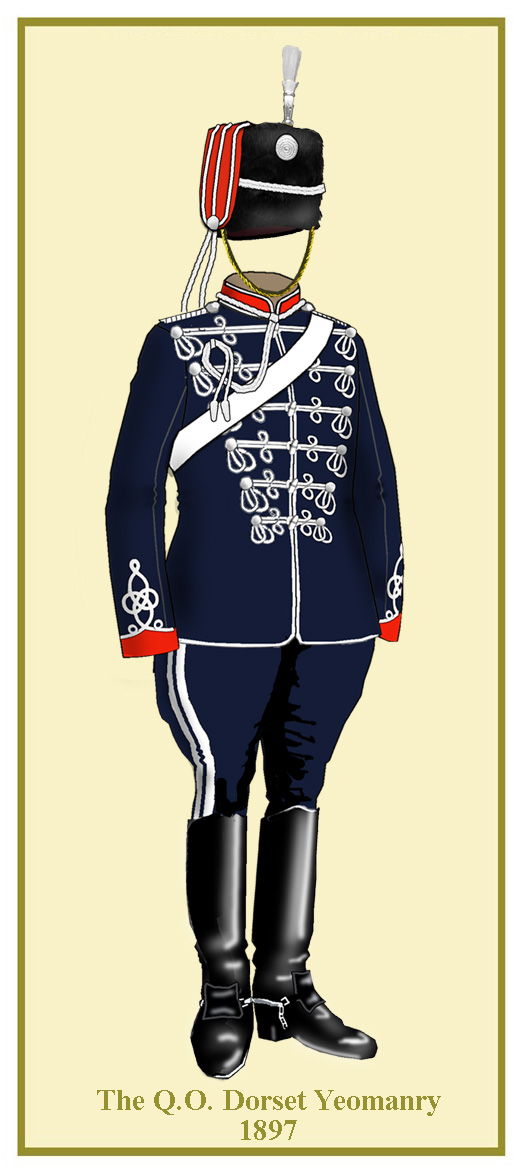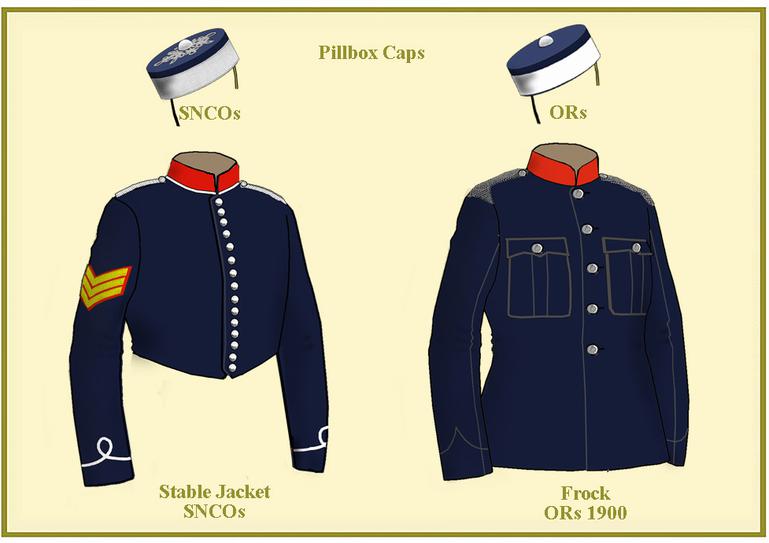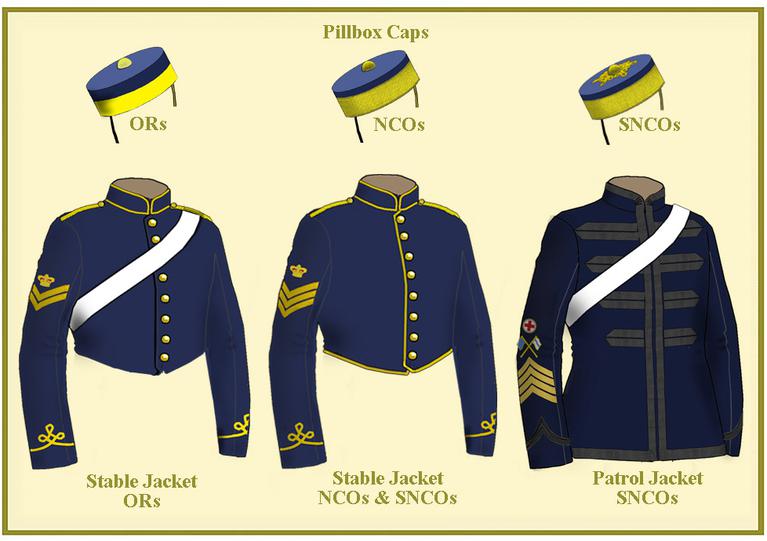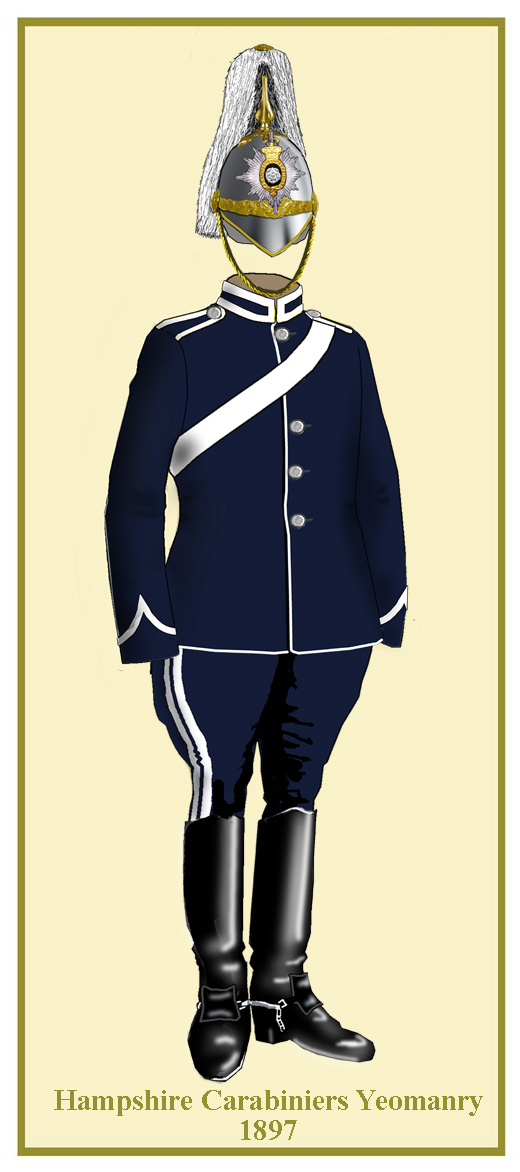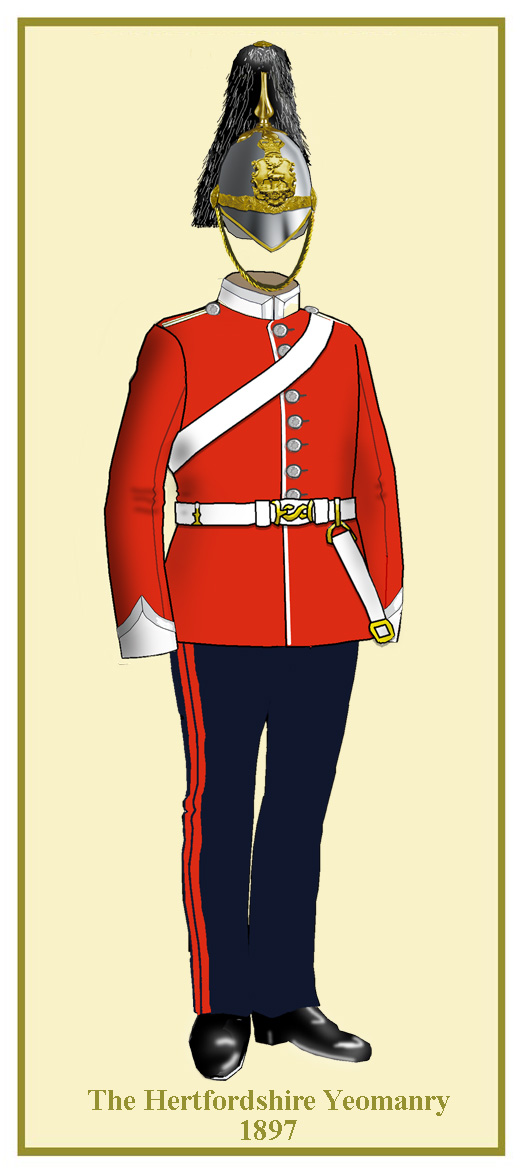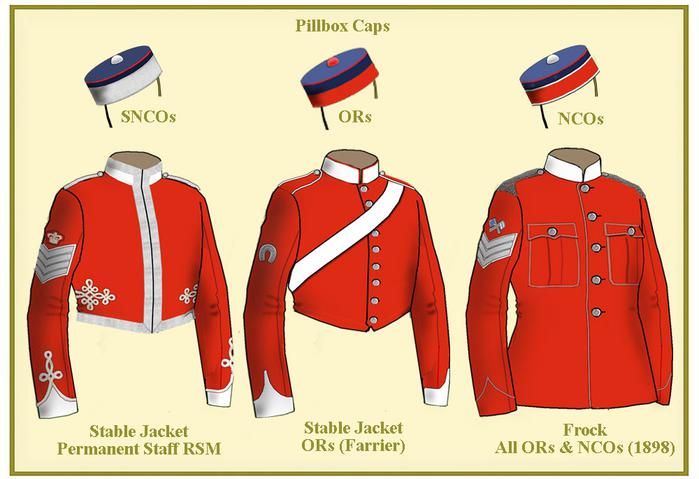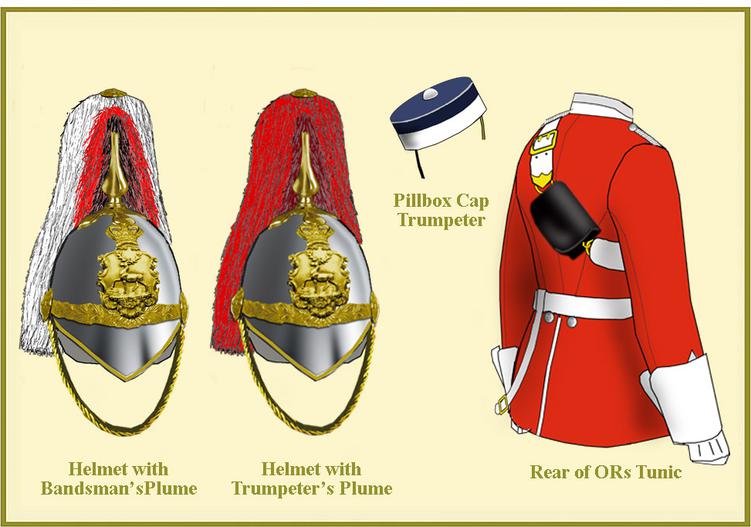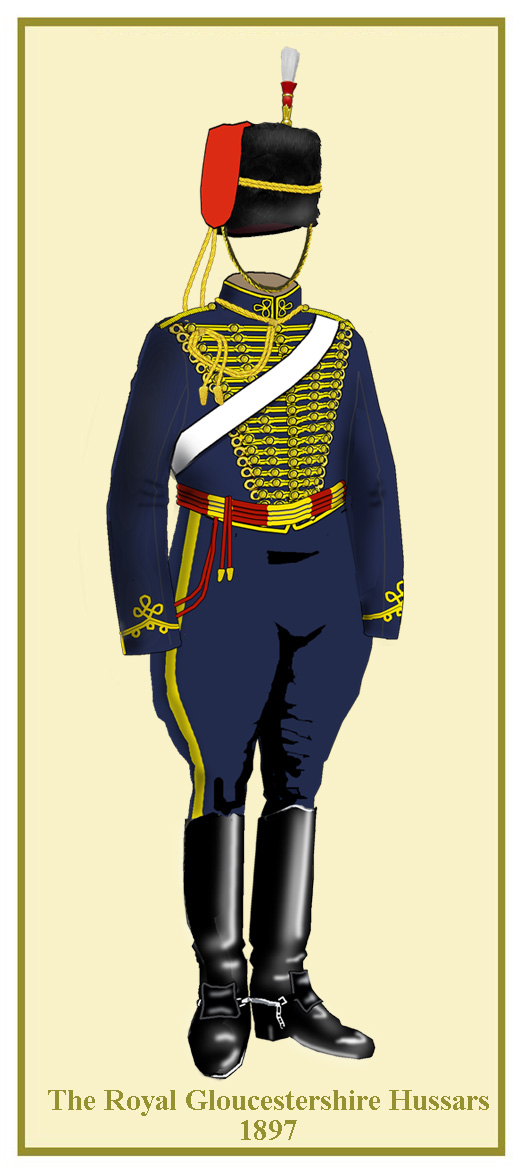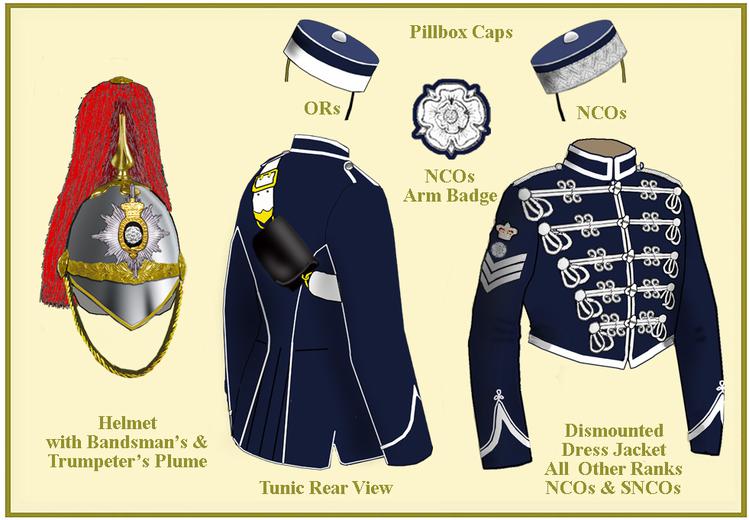The Dorset Yeomanry (Queen's Own)
Ranked No. 23 in Yeomanry Order of preference
Raised as Dorsetshire Regiment of Volunteer Yeomanry Cavalry with six troops in 1794 becoming the Dorsetshire Rangers in 1796 with an additional troop. Disbanded in 1802 they were re-raised the following year with the same title as 1794 but was again disbanded in 1814. It would be 1830 before they were formed once more with the 1794 title. It received royal patronage in 1833 becoming The Princess Victoria's Regiment of Dorset Yeomanry Cavalry and by 1843 the Queen's Own Regiment of Dorset Yeomanry Cavalry. At the end of the century they were known as The Dorset Yeomanry (Queen's Own) headquartered at Weymouth.
Formed 26th Coy of 7th Bn Imperial Yeomanry in 1900
UNIFORMS OF THE BRITISH YEOMANRY REGIMENTS 1895-1900
PART 3
Uniforms
Information on early uniforms of the separate troops is sketchy but the Dorset Rangers of 1796 wore a dark green coat with black lapels and cuffs. A crested black round hat was worn. One of the troops raised in 1803 wore a conventional light dragoon uniform with a light blue jacket an red facings and Tarleton helmet with leopard skin turban. Between 1830 and 1847 the coatee was scarlet with blue facings (befitting its royal patronage) with a bell topped shako. The jacket became blue in about 1850 (presumably with scarlet facings) and later a French style shako was adopted. In the 1860s they were wearing a light dragoon tunic with scarlet collar and cuffs piped white and three loops of frogging across the front. The shako was replaced by a hussar busby in 1883 and the jacket became a full hussar tunic with six loops in 1883. New shorter hussar busbies were issued in 1894 and the uniform became what it was to be for the remainder of the century. The white hussar lacing on the tunic was normal except for the extra curls on the cuffs (each side of the Austrian knots). Undress uniforms followed the normal pattern. The pillbox cap had a white band and button for other ranks while sergeants and above had silver lace and figuring on the crown. A tunic in the regimental museum (The Keep in Dorchester) has gold lace sergeant’s chevrons on the right arm. This could have been so and I have shown it in the illustration but I’ve never seen it described. Scarlet collared blue frocks with shoulder chains were introduced in 1898.
After the Boer War the regiment went into khaki with green collar and cuffs along with the slouch hat. In 1908 they were wearing the blue frock with shoulder chains and scarlet collars. The staff pattern cap was scarlet. At King George Vths coronation they wore white caplines.
The Royal Gloucestershire Hussars
Ranked No. 24 in Yeomanry Order of preference
A troop known as the First Troop of Gloucestershire Gentleman and Yeomanry was raised in 1785 in Cheltenham. More troops were raised in 1797and 98 and in 1803 all were disbanded except the Cheltenham Troop whose turn came in 1814. Troops were again raised in 1830 and in 1834 they were all regimented under the name Gloucestershire Yeomanry Cavalry. They received the prefix “Royal” in 1841 and by 1847 were the Royal Gloucestershire Hussars, a title they retained thereafter. The headquarters remained at Cheltenham.
Formed 3rd Coy of 1st Bn Imperial Yeomanry in 1900
Uniforms
Most of the troops raised before 1814 had light dragoon uniforms mostly with blue or scarlet jackets and Tarleton helmets. Blue was the colour of the light dragoon jackets worn by the troops raised in 1830 with bell topped shakos which had a Maltese cross badge and black horsehair plume. In 1835 the tunic was changed to scarlet and in 1845 the headdress was changed to a cylindrical Austrian style black cloth shako. In 1847 a new uniform was introduced, this was in hussar style and of a colour known as “Badminton” Blue which was slightly lighter than the regular dark blue, but not discernably so except up close. A pelisse was worn by all ranks which presented a distinctly European appearance. The shako was replaced by a busby in 1860 and the regiment’s uniform remained substantially the same until the end of the century. The regimental lace was always gold rather than silver. The other ranks lost the pelisse in 1882 and the yellow of the barreled sash was gold for SNCOs. Undress followed the normal patterns, the stable jacket and pillbox being Badminton blue the former with yellow trefoils on the cuffs and piping on the collar and a simple yellow band and button on the latter. NCOs had gold piping around the front and bottom of the jacket along with the collar piping and trefoils. In the 1890s the regimental sergeant-major, quartermaster and other SNCOs wore a distinctive blue patrol jacket edged with black lace with four black loops across the front while the remainder of the regiment had the standard blue 5 button frock with patch pockets and yellow shoulder cords. Sometime in the 1890s the tradition of full corporals wearing a crown above their chevrons was introduced. This did not apply to sergeants or other senior ranks unless a crown was normal (such as TSMs & SSMs). The regiment wore khaki with blue collars and shoulder straps after the Boer War and full dress was restored in 1906 although the regiment paraded in overalls which had double yellow stripes replacing the single stripe worn before 1900. The barreled sash for other ranks was also discontinued. Badminton blue staff pattern caps were worn although busbies were issued to the contingent at George Vths coronation.
The Hampshire Yeomanry (Carabiniers)
Ranked No. 20 in Yeomanry Order of preference
Many troops of yeomanry cavalry were raised in the southern part of England between 1794 and 1803 and brought under the general designation of North Hampshire Yeomanry. Most disappeared in 1815. Troops were brought together again as the North Hampshire Regiment of Yeomanry Cavalry in 1834 with the “North” designation lost in the eighteen forties. In 1884 the regiment became the Hampshire Carabiniers Yeomanry. In 1897 they were known as The Hampshire Yeomanry (Carabiniers) with headquarters at Winchester.
Formed 41st Coy of 4th Bn Imperial Yeomanry in 1900
Uniforms
Although one must assume they generally wore the same light dragoon style with Tarleton helmets, the various troops raised in Hampshire and surrounding areas wore different coloured uniforms. Most wore blue jackets with the Bere Forest and South Hampshire with red facings, the Fawley and Southampton black, the Ringwood white and the Fordingbridge none. The New Forest Rangers wore green with black facings. In the eighteen thirties the newly raised North Hampshire troop wore blue hussar style uniforms faced white without pelisses and bell topped shakos. The Lymington squadron wore a green light dragoon uniform with black facings again with a bell topped shako. By 1848 these had merged into one regiment retaining the uniform of the North Hampshire troop with an Albert shako. In 1861 the shako was changed to a French style kepi in blue cloth with white piping and a white drooping plume. At the same time the regiment adopted the short hussar jacket with five loops of white frogging. This uniform remained unchanged in principle until 1884 when a change in command brought forth a white metal 1874 pattern dragoon helmet with brass fittings. Plumes for the helmet were not issued to the regiment until late 1887 and they were white for all except the band and trumpeters who wore red plumes. By 1885 the frogged jacket had been replaced by a blue frock with white lace on collar and cuffs and white piping down the front and on the rear seams of the jacket and sleeves. This jacket was always intended to be used as a working uniform and consequently the regiment never adopted a stable jacket at this time. The old frogged hussar jacket was now used as a dismounted parade uniform, often worn with the helmet and dress overalls. Ranks of sergeant and above wore a white metal rose above the chevrons. This arm badge dates from about 1887. A blue 5 button frock with patch pockets replaced the piped tunic in 1897 which was worn with the pillbox. No record of folding field caps at this time. After the Boer War khaki uniform with white collars and cuff trefoils were worn. In 1908 the regiment generally wore the blue frock with white collar patches, white striped overalls and the blue staff pattern cap with white piping. In 1911 the coronation contingent appeared in full dress with blue tunics patterned on the 6th Dragoon Guards but with blue and white striped lancer girdles and white gauntlets. A very attractive ensemble.
The Hertfordshire Yeomanry
Ranked Ranked No. 25 in Yeomanry Order of preference
Five troops of yeomanry cavalry were raised in Hertfordshire in 1794 and 1803. All were independent and disbanded between 1807 and 1824. In 1830 seven more independent troops were formed, four of which became the South Hertfordshire Corps. The surviving troop of the other three became the North Hertfordshire Corps and was amalgamated with the other to form The Hertfordshire Yeomanry Cavalry in 1871. It was headquartered in Hatfield in 1897.
Formed 42nd Coy of 12th Bn Imperial Yeomanry in 1900
Uniforms
The yeomanry corps raised between 1794 and 1803 wore the standard light dragoon uniform with blue jackets faced red except for the Beechwood troop who wore green jackets no facings and a civilian style black round hat with black plume. These colours seem to have been retained until all were disbanded in 1824 although the headdresses probably changed in style. Upon the re-raising of the various corps in 1830 the largest, South Hertford corps wore a green light dragoon pattern uniform with red plastron and facings. The Bell topped shako had a Maltese cross device with the “Hart” in the centre. There is very little information on the other three troops that disappeared in the late 1830s except that the St. Albans and Dacorum troops were dressed as heavy cavalry with scarlet coats and green facings. A surviving Romanesque crested helmet from the Dacorum troop is white metal with Maltese cross plate and black falling horsehair plume. The North Hertford troop probably wore blue jackets with red facings although not much evidence is available. Whether coatees were exchanged for tunics after 1856 is not known for any of the Hertford corps.
In about 1865 the remaining troops were merged and a heavy cavalry dragoon uniform was adopted. This uniform remained substantially unaltered until the end of the century. The tunic was scarlet with white collars and pointed cuffs all edged with a ½ inch silver lace (the collar & front only). The lower part of the collar had thin silver lace. The rear skirt had a single white piping at the vent. White gauntlets were worn. Overalls were dark blue with double scarlet stripes and knee boots and pantaloons were taken into wear in 1876. The white metal spiked helmet with brass fittings worn from 1852 without plume until 1880 when black plumes were introduced for the officers and troopers with white over red for the band and red for trumpeters.
Undress included scarlet stable jackets for men with white collar and cuffs with nine white metal buttons down the front. The only distinction for NCOs appear to be thicker edging on the shoulder straps. The stable jacket worn by the Regimental Sergeant Major (permanent staff) was most unique with the extra silver gimp figuring on cuffs, collar and at the waist as well as the lace down the front and lower edge. Pillbox caps had scarlet edging to the crown by all ranks except officers. The regular privates had scarlet bands, sergeants scarlet with silver edging and senior NCOs silver lace. Trumpeters had white bands and crown piping. It is not known whether the band wore the same pillboxes. In 1898 scarlet five button frocks with patch pockets were introduced. The collars were white and had chains on the shoulders.After the Boer War khaki jackets with scarlet collar, cuffs and shoulder strap piping were worn. The slouch hat was worn until 1906 when plain khaki peaked caps were issued. After 1908 the regiment was meant to wear blue frocks without facings and blue staff pattern caps with white band and piping. These caps were worn at the 1911 coronation but with the white collared scarlet frocks.
Dorset Yeomanry
Royal Gloucestershire Hussars
Hampshire Yeomanry (Carabiniers)
Hertfordshire Yeomanry



